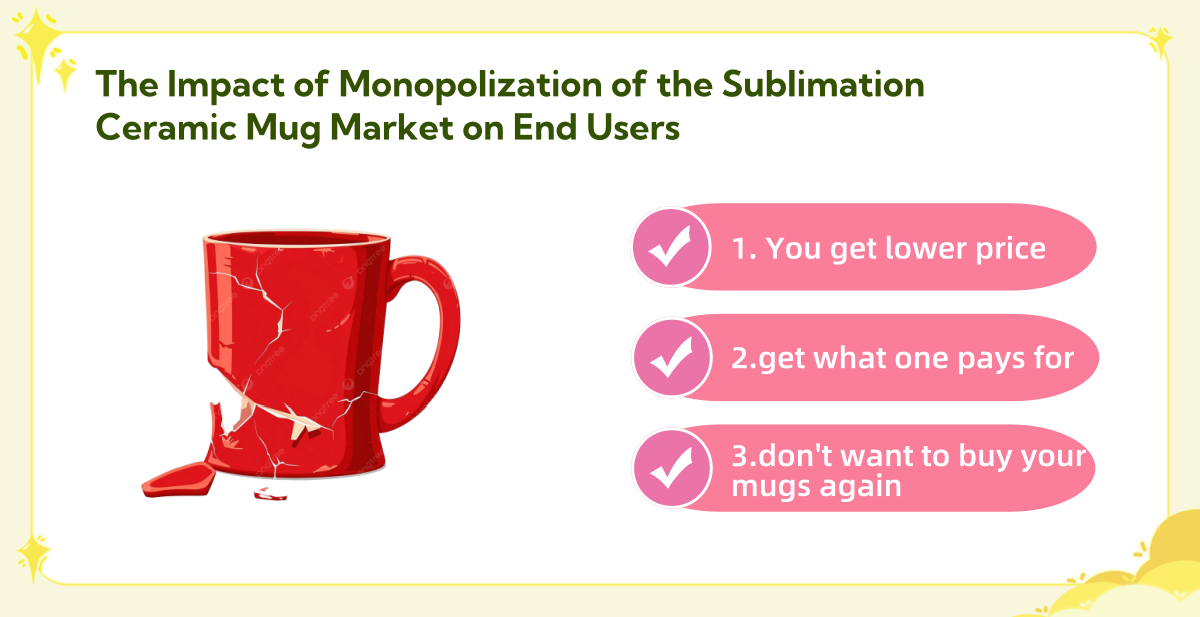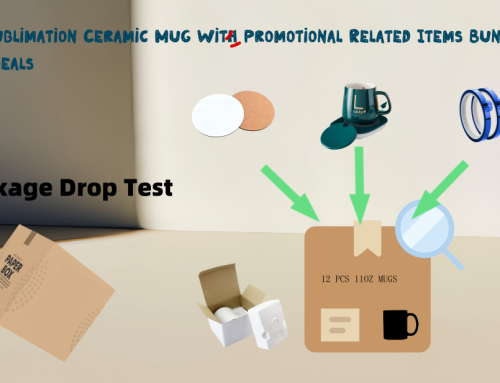Impact of Monopolization of the Sublimation Ceramic Mug Market on End Users
Impact of Monopolization of the Sublimation Ceramic Mug
The global market for sublimation ceramic mugs has expanded rapidly in recent years, with several dominant companies commanding the majority of market share. These companies have successfully captured a large customer base by offering lower prices, more aggressive marketing strategies, and leveraging economies of scale. However, this monopolization—where a few key players dominate the market—has led to a series of challenges for both consumers and smaller manufacturers. This article explores the potential impacts of monopolization on the end users of sublimation ceramic mugs, focusing on the implications of product quality, customer service, price fluctuations, and market diversity.
Impact of Monopolization of the Sublimation Ceramic Mug

1. Decline in Product Quality
When the sublimation ceramic mug market is monopolized, product quality often takes a backseat to cost-cutting measures. In a competitive market, businesses strive to differentiate themselves through superior quality, unique designs, and custom features. However, monopolistic companies, especially those operating at a large scale, tend to focus on mass production to maximize profits. This inevitably leads to compromises in quality, as manufacturers are more focused on producing large quantities of mugs quickly and cheaply.
The sublimation process itself is highly sensitive and requires precision in temperature control and material quality. In monopolized markets, companies often use cheaper materials to reduce costs. As a result, sublimation ceramic mugs may suffer from issues such as poor image transfer, fading prints, and weak ceramic structures. This compromises the overall longevity and aesthetic appeal of the mugs, leaving customers dissatisfied with their purchases.
Additionally, large-scale manufacturers may not be as diligent in ensuring consistent quality across all products. For example, automated production lines that handle mass production are prone to errors, resulting in defects in some batches of mugs that consumers might not immediately notice. In contrast, smaller, specialized manufacturers that focus on quality are often excluded from the market or forced to lower their standards to compete, leaving end users with subpar products.
2. Diminished Customer Service
Impact of Monopolization of the Sublimation Ceramic Mug
Another significant impact of monopolization on end users is the decline in customer service. When the market is dominated by a few key players, customers may find themselves at the mercy of companies that are less incentivized to provide high-quality customer support. In a competitive environment, companies strive to distinguish themselves by offering responsive customer service, handling returns or issues quickly, and ensuring that customers are satisfied with their purchases. However, in a monopolized environment, where competition is reduced, companies may view customer service as a secondary concern.
Impact of Monopolization of the Sublimation Ceramic Mug
Large corporations that control the majority of the market are typically less focused on providing personalized service. Their customer service departments may be understaffed, leading to longer wait times for support, lower-quality interactions, and unhelpful responses to customer inquiries or complaints. For customers purchasing sublimation ceramic mugs with issues such as defective prints or poor quality, the process of getting a refund, replacement, or resolution becomes increasingly difficult and frustrating.
Impact of Monopolization of the Sublimation Ceramic Mug
This situation is especially problematic for end users who are used to receiving prompt and effective customer service from smaller, more agile businesses. Smaller manufacturers, which typically emphasize high-quality service, are unable to compete in a monopolized market and are often forced out by the pricing and marketing power of larger players. Consequently, end users lose access to more personalized, customer-centric service that could have made their experience more positive.
3. Price Inflation and Limited Affordability
Impact of Monopolization of the Sublimation Ceramic Mug
While the initial impact of monopolization on price may seem like an advantage for consumers—due to lower prices driven by economies of scale—the long-term effects are generally negative. Monopolistic companies gain significant control over pricing when there are few competitors in the market. Without the pressure to match prices or innovate, dominant players are free to raise prices at will.
For sublimation ceramic mugs, the lack of competition means that prices can slowly creep up, even if the quality of the product does not improve. Additionally, because monopolies control production and distribution, they may impose price hikes on accessories, printing services, or shipping fees, further inflating the cost of purchasing custom sublimation mugs. As a result, consumers may end up paying more for mugs that are of inferior quality, particularly when there are no viable alternatives available.
While price is a crucial factor in the decision-making process for many customers, the trade-off between price and quality can be substantial. When monopolistic companies control pricing structures, consumers are left with little choice but to pay for products that offer poor value for money. This price inflation can be especially burdensome for small businesses that rely on selling sublimation mugs for promotional purposes or as a source of income. These small businesses are often forced to raise their prices, which can lead to lower sales and, ultimately, a less sustainable business model.
4. Stifled Innovation and Customization
Impact of Monopolization of the Sublimation Ceramic Mug
One of the most significant drawbacks of a monopolized market is the stifling of innovation. In a competitive environment, companies are constantly pushing to innovate—whether by offering new designs, materials, or processes. Innovation allows consumers to access new and exciting products that better meet their needs. However, when a few companies monopolize the sublimation ceramic mug market, the drive for innovation diminishes. Large, monopolistic players may focus primarily on maximizing production efficiency and cutting costs rather than exploring new technologies or creative designs.
Customization, a key selling point for many sublimation mug buyers, is also likely to suffer in a monopolized market. Consumers increasingly want personalized products, whether it be mugs with custom designs, logos, or images. Smaller companies often specialize in these unique offerings and can provide a higher level of customer satisfaction by tailoring products to specific demands. However, when a few companies dominate the market, they may not prioritize such bespoke services, as offering mass-produced mugs with generic designs is more profitable.
Moreover, the manufacturing processes employed by large companies are often less flexible and unable to accommodate highly customized orders. As a result, end users may find it more difficult to access unique, personalized mugs. This diminishes consumer choice and limits the creative possibilities that were once available through smaller, more specialized manufacturers.
5. Increased Barriers to Entry for Smaller Manufacturers
Impact of Monopolization of the Sublimation Ceramic Mug
As monopolistic companies continue to dominate the sublimation ceramic mug market, the barriers to entry for smaller manufacturers become increasingly difficult to overcome. These barriers can include high capital investment, access to raw materials, distribution channels, and marketing budgets. The concentration of market power in the hands of a few large players makes it nearly impossible for smaller businesses to compete, particularly when the larger companies benefit from economies of scale and established customer bases.
For consumers, this means that the diversity of products in the market shrinks. Small, independent manufacturers who once provided high-quality, artisanal, or custom sublimation mugs will struggle to survive. The overall variety of products available to consumers is reduced, and the market becomes increasingly homogeneous, dominated by the offerings of a few large companies. This lack of variety impacts end users who seek unique products or high-quality craftsmanship and may lead to frustration as they are forced to settle for mass-produced, low-quality mugs.
6. Ethical Concerns and Sustainability
Impact of Monopolization of the Sublimation Ceramic Mug
Monopolistic control over the sublimation ceramic mug market can also have ethical and environmental implications. Large corporations often prioritize profitability over sustainability or ethical manufacturing practices. As monopolists seek to maximize their margins, they may cut corners in terms of sourcing materials, labor practices, and environmental impact. For example, they might use lower-quality, non-sustainable raw materials or outsource production to countries with lax labor laws, resulting in unethical working conditions.
For consumers who are concerned about the ethical impact of their purchases, the monopolization of the market makes it harder to find products that align with their values. Smaller companies that emphasize sustainability, ethical sourcing, or fair labor practices are often crowded out by the market dominance of larger players. This leaves consumers with fewer options to choose products that align with their ethical and environmental preferences.
7. Conclusion: The Adverse Effects of Monopolization on End Users
Impact of Monopolization of the Sublimation Ceramic Mug
The monopolization of the sublimation ceramic mug market brings a host of negative consequences for end users. While the initial appeal of lower prices may seem advantageous, the long-term impacts—ranging from poor product quality and customer service to reduced innovation and ethical concerns—are considerable. Consumers will find themselves with limited choices, higher prices, and subpar products that fail to meet their expectations.
In addition, smaller manufacturers and businesses that focus on quality, customization, and customer service will struggle to survive in a monopolized environment. The loss of diversity in the marketplace, coupled with the reduction in ethical manufacturing practices, will leave consumers with fewer avenues to make purchases that align with their values.
Ultimately, the monopolization of the sublimation ceramic mug market harms both the consumer experience and the overall health of the industry. Preserving competition is essential for ensuring that end users continue to have access to high-quality, innovative, and affordable products while maintaining a diverse and sustainable marketplace.
Impact of Monopolization of the Sublimation Ceramic Mug







